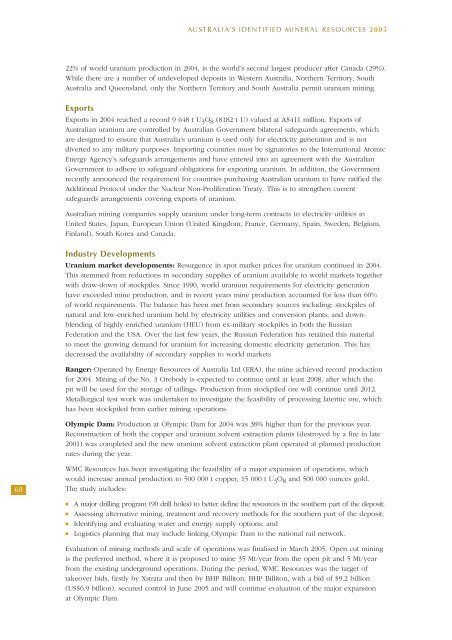australia's identified mineral resources 2005 - Geoscience Australia
australia's identified mineral resources 2005 - Geoscience Australia
australia's identified mineral resources 2005 - Geoscience Australia
You also want an ePaper? Increase the reach of your titles
YUMPU automatically turns print PDFs into web optimized ePapers that Google loves.
AUSTRALIA’S IDENTIFIED MINERAL RESOURCES <strong>2005</strong><br />
22% of world uranium production in 2004, is the world’s second largest producer after Canada (29%).<br />
While there are a number of undeveloped deposits in Western <strong>Australia</strong>, Northern Territory, South<br />
<strong>Australia</strong> and Queensland, only the Northern Territory and South <strong>Australia</strong> permit uranium mining.<br />
Exports<br />
Exports in 2004 reached a record 9 648 t U 3 O 8 (8182 t U) valued at A$411 million. Exports of<br />
<strong>Australia</strong>n uranium are controlled by <strong>Australia</strong>n Government bilateral safeguards agreements, which<br />
are designed to ensure that <strong>Australia</strong>’s uranium is used only for electricity generation and is not<br />
diverted to any military purposes. Importing countries must be signatories to the International Atomic<br />
Energy Agency’s safeguards arrangements and have entered into an agreement with the <strong>Australia</strong>n<br />
Government to adhere to safeguard obligations for exporting uranium. In addition, the Government<br />
recently announced the requirement for countries purchasing <strong>Australia</strong>n uranium to have ratified the<br />
Additional Protocol under the Nuclear Non-Proliferation Treaty. This is to strengthen current<br />
safeguards arrangements covering exports of uranium.<br />
<strong>Australia</strong>n mining companies supply uranium under long-term contracts to electricity utilities in<br />
United States, Japan, European Union (United Kingdom, France, Germany, Spain, Sweden, Belgium,<br />
Finland), South Korea and Canada.<br />
Industry Developments<br />
Uranium market developments: Resurgence in spot market prices for uranium continued in 2004.<br />
This stemmed from reductions in secondary supplies of uranium available to world markets together<br />
with draw-down of stockpiles. Since 1990, world uranium requirements for electricity generation<br />
have exceeded mine production, and in recent years mine production accounted for less than 60%<br />
of world requirements. The balance has been met from secondary sources including: stockpiles of<br />
natural and low-enriched uranium held by electricity utilities and conversion plants; and downblending<br />
of highly enriched uranium (HEU) from ex-military stockpiles in both the Russian<br />
Federation and the USA. Over the last few years, the Russian Federation has retained this material<br />
to meet the growing demand for uranium for increasing domestic electricity generation. This has<br />
decreased the availability of secondary supplies to world markets<br />
Ranger: Operated by Energy Resources of <strong>Australia</strong> Ltd (ERA), the mine achieved record production<br />
for 2004. Mining of the No. 3 Orebody is expected to continue until at least 2008, after which the<br />
pit will be used for the storage of tailings. Production from stockpiled ore will continue until 2012.<br />
Metallurgical test work was undertaken to investigate the feasibility of processing lateritic ore, which<br />
has been stockpiled from earlier mining operations.<br />
Olympic Dam: Production at Olympic Dam for 2004 was 38% higher than for the previous year.<br />
Reconstruction of both the copper and uranium solvent extraction plants (destroyed by a fire in late<br />
2001) was completed and the new uranium solvent extraction plant operated at planned production<br />
rates during the year.<br />
68<br />
WMC Resources has been investigating the feasibility of a major expansion of operations, which<br />
would increase annual production to 500 000 t copper, 15 000 t U 3 O 8 and 500 000 ounces gold.<br />
The study includes:<br />
■<br />
■<br />
■<br />
■<br />
A major drilling program (90 drill holes) to better define the <strong>resources</strong> in the southern part of the deposit;<br />
Assessing alternative mining, treatment and recovery methods for the southern part of the deposit;<br />
Identifying and evaluating water and energy supply options; and<br />
Logistics planning that may include linking Olympic Dam to the national rail network.<br />
Evaluation of mining methods and scale of operations was finalised in March <strong>2005</strong>. Open cut mining<br />
is the preferred method, where it is proposed to mine 35 Mt/year from the open pit and 5 Mt/year<br />
from the existing underground operations. During the period, WMC Resources was the target of<br />
takeover bids, firstly by Xstrata and then by BHP Billiton. BHP Billiton, with a bid of $9.2 billion<br />
(US$6.9 billion), secured control in June <strong>2005</strong> and will continue evaluation of the major expansion<br />
at Olympic Dam.

















